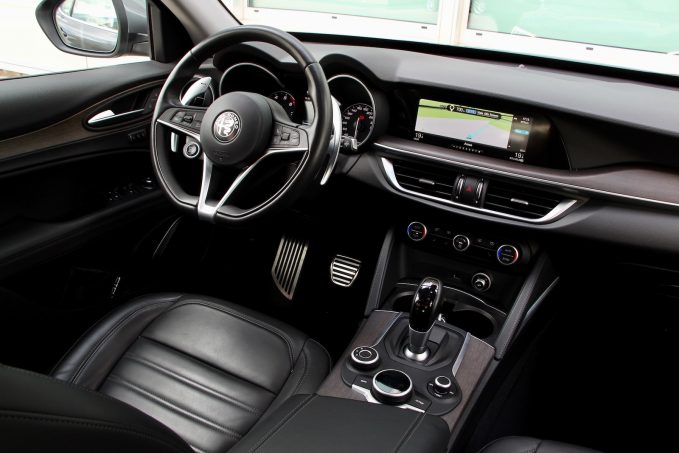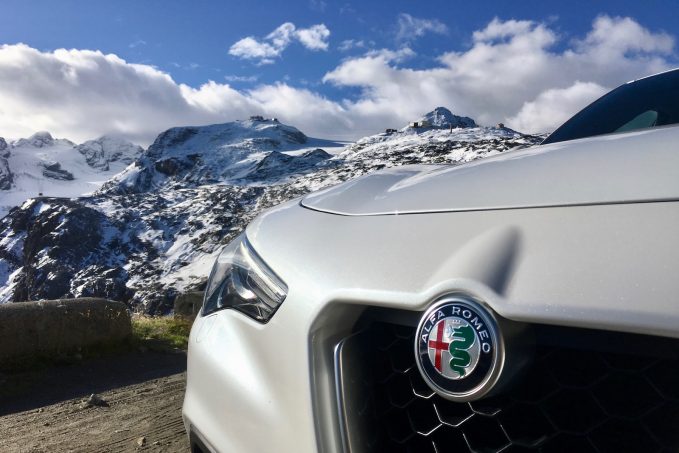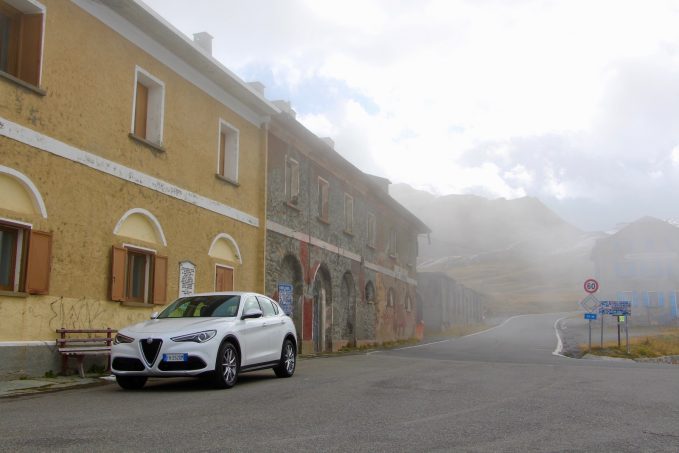If an automaker wants to play in North America, they need an SUV.
Alfa Romeo has been back in North America for several years now, but despite launching with a sexy, unadulterated purist’s sports car, and then a midsize sedan that is still hella sexy, neither of those segments are lighting the market on fire, so It’s been a slow start for the brand.
In order to truly compete in the luxury scene, Alfa Romeo needs an SUV, and this is it, the 2018 Alfa Romeo Stelvio. The Stelvio was developed in tandem with the Giulia sedan, sharing the “Giorgio” platform (random aside: Alfa Romeo has got some crazy cool names!) and designed to offer the typical cargo and practicality advantages of the hatchback, and a bit more rugged capability of added ground clearance and standard AWD.
Practical Considerations
Since I know you’re dying to hear all about the dimensions, cargo space, and interior space, let’s dive right into the fun stuff: The Stelvio retains the same wheelbase (111 inches/2,820 mm) as the Giulia but gets a wider track and is longer overall (185 in/4,698 mm) for all that awesome cargo space that you want to hear about. The trunk space is 18.5 cu-ft (525 L) and the rear seats can be folded down to open up 56.5 cu-ft (1,600 L) if you need to bring home a dishwasher. Alfa benchmarked the Audi Q5, Porsche Macan, and BMW X3 (not the new one, of course), and although the Stelvio is longer than any of those, it’s only better than the Macan for cargo space, while the Q5 and X3 beat it with seats up or down.
ALSO SEE: 2017 Alfa Romeo Stelvio Video, First Look
If you’re just hauling the family, the rear seat is fine for kids but falls short of its competitors in the luxury class, never mind mainstream compacts like the Honda CR-V or Nissan Rogue. While the Stelvio isn’t as practical as those standouts, at least it has two and a half inches (65 mm) more ground clearance than the Giulia for almost eight inches (200 mm) to get through deeper snow and ruts. It can’t tackle the Rubicon Trail, but can certainly get you to your cottage and over some bumps. The other benefit to the raised height is the higher seating position, and the driver’s seat in the Stelvio is about 7.5 inches (190 mm) higher than in the Giulia, offering a better vantage point for seeing obstacles ahead, and rear seats are easier to access for child seat installation. The front seats are also extremely comfortable and even after a couple long days on the road, I felt fresh and limber with no back pain.
Dynamic Character
However, the downside to the added height is body roll and the hatch format adds weight, both enemies to the sporty dynamic and emotional appeal that Alfa is trying to sell. To combat this, Alfa retained the suspension architecture from the Giulia, but dialed in spring and damper stiffness to accommodate the extra weight and height. The goal of the revised suspension was to retain the same “roll profile” as the Giulia, meaning that despite being positioned higher, the car will rotate on a point relative to the driver similar to the Giulia. In simpler terms, they aimed to make it feel like a sedan. Well, with 19-inch wheels (20-inch wheels are optional) and a sporty suspension as equipped, it certainly felt suitably sporty to my butt.
Alfa also makes grand claims about the roll stability relative to competitors’ crossovers and sedans, and while it might improve upon base models or previous generations they had on hand to benchmark, the bar is constantly changing and it would take a more direct comparison to agree that they have improved upon the new Audi Q5 or will measure up to the upcoming Volvo XC60.
The Competition: 2018 Audi Q5 and 2018 Volvo XC60
To show off its sporty DNA, Alfa Romeo brought us to Italy to test the Stelvio on its namesake, the Stelvio Pass. Stelvio is a great name for an Italian vehicle and conjures up images of romantic mountain passes and Top Gear episodes, but it’s not necessarily the best place to test a luxury SUV. No matter how agile and responsive your SUV is, it will feel large, cumbersome and claustrophobic on the Stelvio Pass, whose 75 hairpin turns offer a neverending series of sphincter-clenching moments as you negotiate every corner hoping that there will not be a motorcycle barreling down the middle of the road or a truck occupying pretty much the entire width of the narrowest sections.
In reality, it is the early stretch and tail end of the pass that highlight the Stelvio SUV’s excellent steering, well-balanced shock absorption, and stable handling, and that’s without the optional adaptive damping system. It really is quite fun to drive when you don’t feel like it does not have a tight enough turning circle to negotiate the tighter hairpins and feels too wide to slip by a delivery truck, or handcuffed by impossible sight angles that even a convertible would be challenged to deal with. Coming out of turns when the coast is clear, though, the Stelvio’s rear-biased AWD was appreciated, also aided by brake-based torque vectoring, although a mechanical locking rear differential is available as an option. And the brakes, even with all that workload, never wavered even after the serious workout of going up, down, and then back again, with good feel to help you feel comfortable even when there is a big surprise around the corner.
Plenty of Power
One thing that we were able to experience to its full advantage in the mountain pass was the power on tap every time we came crawling out of a corner. Equipped with a 2.0-liter turbo typical for the segment, the Stelvio’s powerplant pumps out 280 hp and 306 lb-ft of torque available from 2,250 to 4,500 rpm. That is plenty of flexibility, so the Stelvio, which weighs just 3,536 pounds (1,604 kg), gets moving while still feeling relaxed, a trait many luxury buyers will be sure to appreciate. Of course, it’s no V8, and while it does not moan and drone like some 2.0T powertrains, it’s not a soundtrack to get thrilled about – they’re saving that for the 500-hp Quadrifoglio, no doubt.
ALSO SEE: 2017 Alfa Romeo Giulia Quadrifoglio Review
Paired with an eight-speed automatic transmission that can be switched to manual mode and controlled by paddle shifters, you can grab as low a gear as you want and feel that power surge up the inclines for several thousand rpm before grabbing the next gear, though it was rare to get beyond fourth gear on this climb. In manual mode or dynamic setting, the transmission was always game, with quick sharp gear changes, but it wasn’t at the expense of harshness or any problems in city traffic or cruising along highways.
Alfa Romeo estimates the run to 60 mph 5.4 seconds (0-100 km/h in 5.7 seconds), so it’s certainly sufficient for the school run or commute to the office that it will spend most of its days conquering. In that setting, the Alfa Romeo Stelvio manages an efficient 22 mpg in the city, 28 on the highway and 24 mpg combined (10.8 / 8.3 / 9.6 L/100 km), which is respectable for the segment.
Details, Details
In the drudgery of daily life, the Stelvio will be practical enough, although there are some quirks to the interior that might take some getting used to. The infotainment system is displayed on a wide screen that is not very tall, and the maps did not zoom out nearly far enough for my preferences (to see a larger overview of the route). Although not uncommon, the maps were not up to date on certain sections of our drive, so if you rely heavily on route guidance, caveat emptor (c’mon, we were in Italy driving an Italian car, you knew I had to get some Latin in there somewhere… Just be glad I don’t start quoting Pliny the Elder). Another oddity is the wiper stalk, as it was a bit of a mystery to decipher how to activate just a quick wipe of the rear wiper.
Then again, those are minor things to overlook if the Stelvio proves itself to be a luxurious and reliable family vehicle. This being the luxury segment, quality will also be judged, and while there are many nice materials, with fine leather and genuine wood and metal trims, different switchgear than its Dodge and Chrysler corporate siblings, it’s somewhat midpack for fit, finish and plastics throughout the cabin. As to reliability, the Giulia has had some teething problems to say the least, but it is still too early to tell if those issues have been sorted for the Stelvio, or will persist and bury the Alfa Romeo brand before it can even be fully resurrected.
The Verdict: 2018 Alfa Romeo Stelvio First Drive Review
The Stelvio is the car that will make or break Alfa Romeo in North America. Success means it has a foothold in the world’s second-biggest market (China is tops now) and finally another brand helping Jeep carry the weight at FCA. Poor or mediocre sales means the Alfa Romeo brand in North America will continue to be a drain on resources for FCA, trying to recapture the glory of past affection and the attention of a new generation. Alfa would not share its sales expectations, but surely they are keeping a close watch on Jaguar sales and matching the F-Pace or Range Rover Evoque would be a great place to start.
Pricing and Trims: 2018 Alfa Romeo Stelvio Priced Competitively at $42,990
As much as this segment is growing, competition is fierce and Alfa needed something distinctive, which it has delivered, with unique and attractive styling, sufficient practicality, modern amenities and standout driving dynamics that the brand is hanging its hat on. With a properly raucous Quadrifoglio on the way to draw attention to the brand and model, the 2018 Alfa Romeo Stelvio has just enough of what people need, plus something special to attract willing buyers and help this Italian brand stick
in North America this time around.












